Sir John Monash, Personal Files Book 12, 3 April - 30 April 1916, Part 2
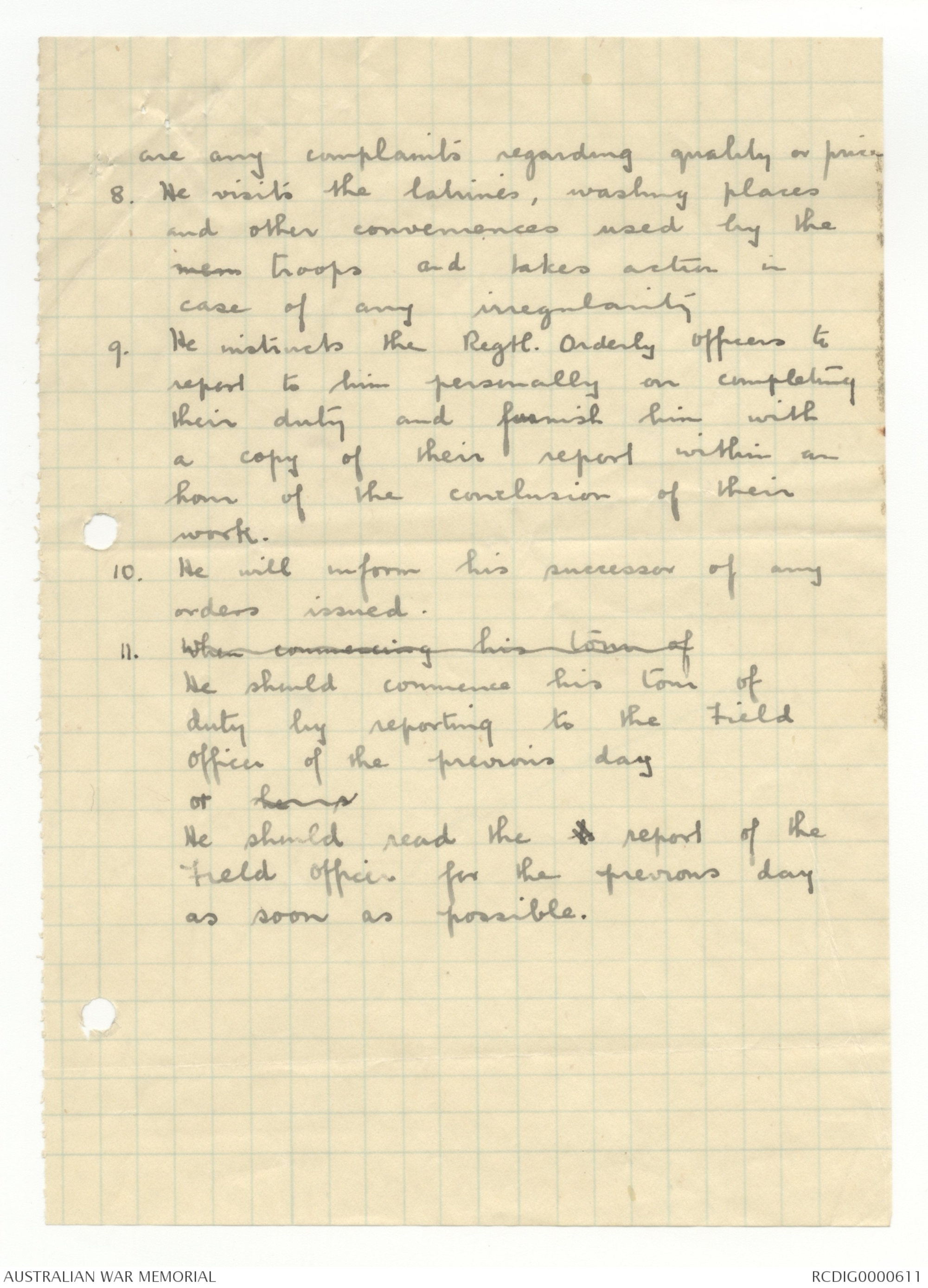
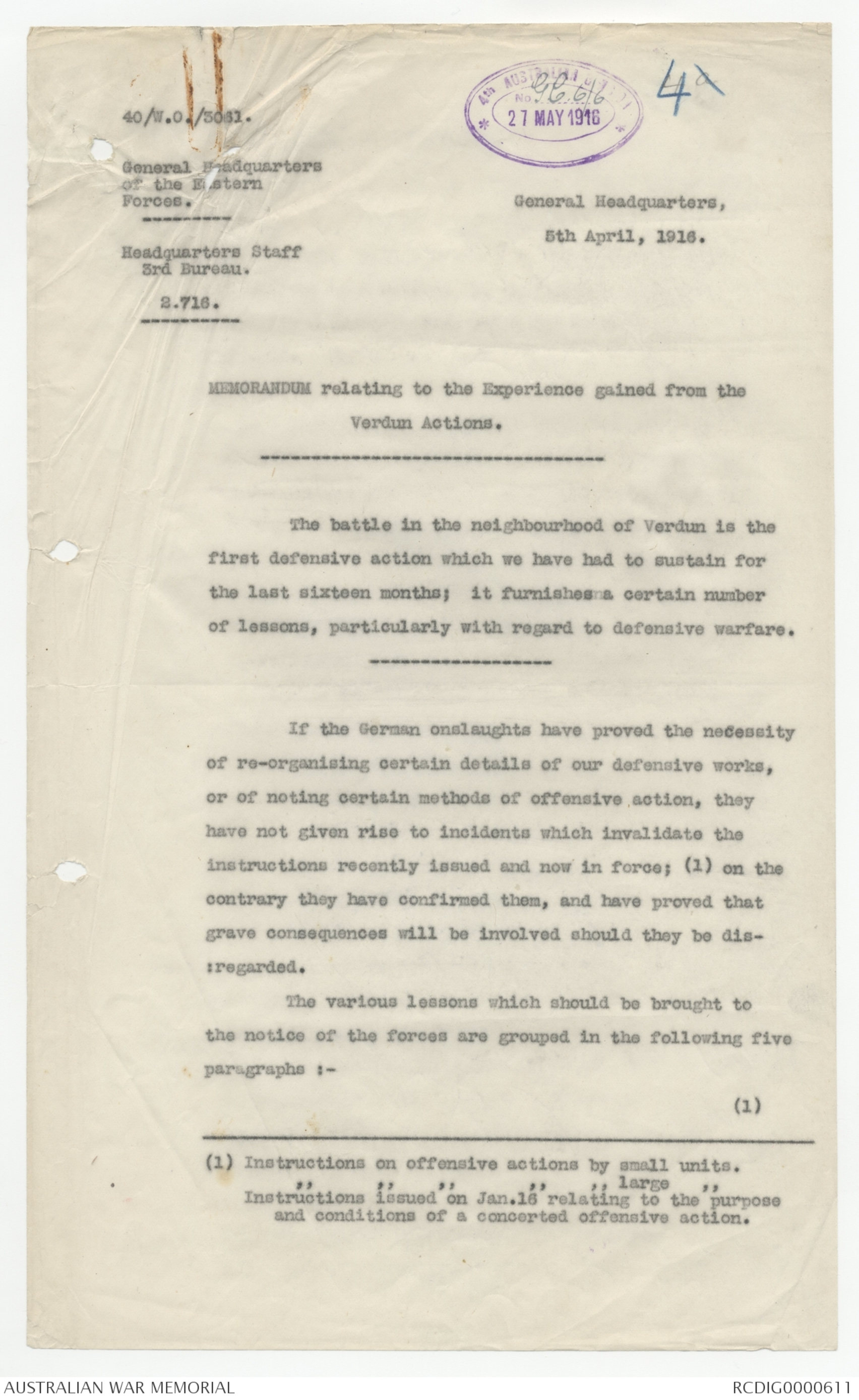
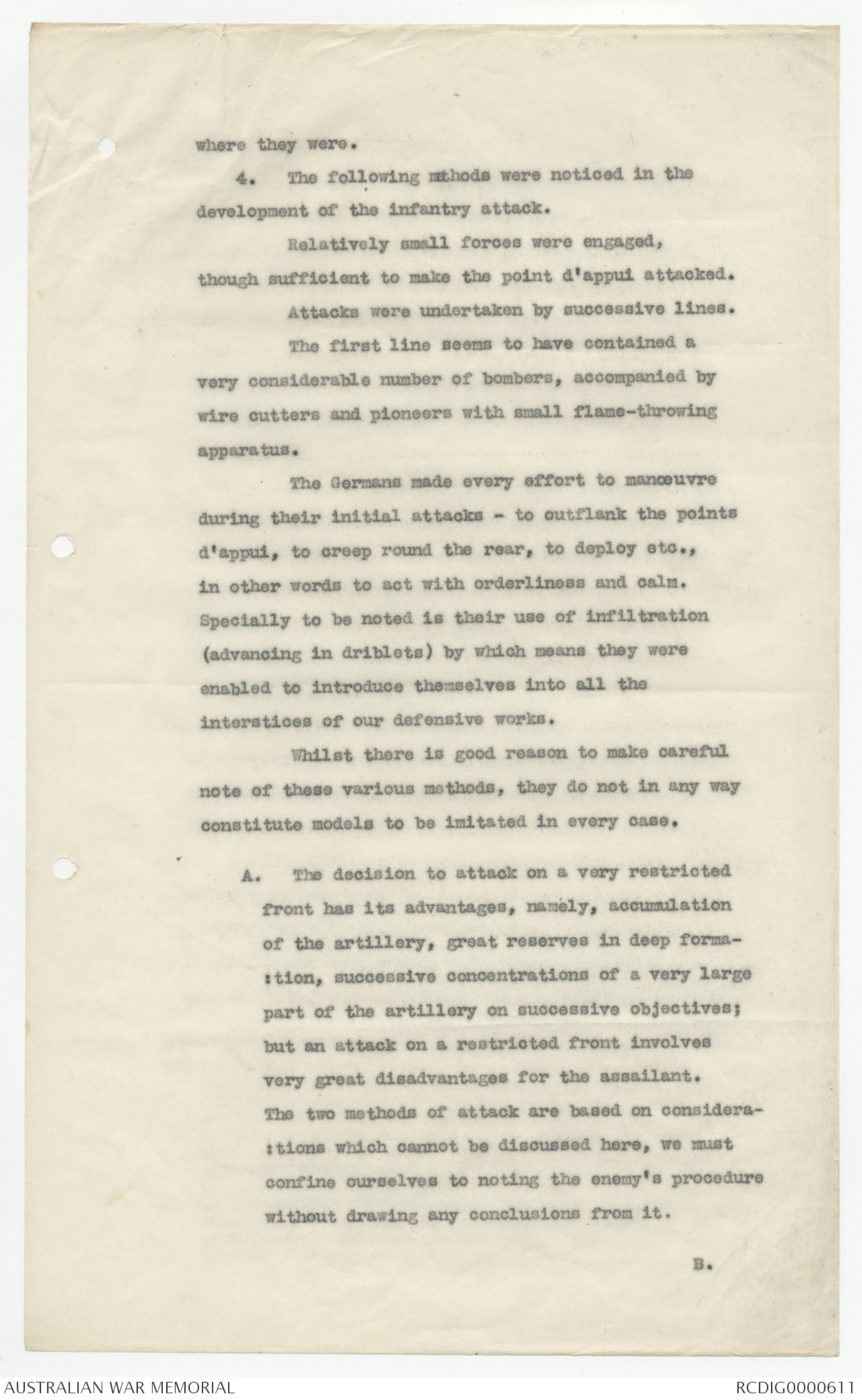
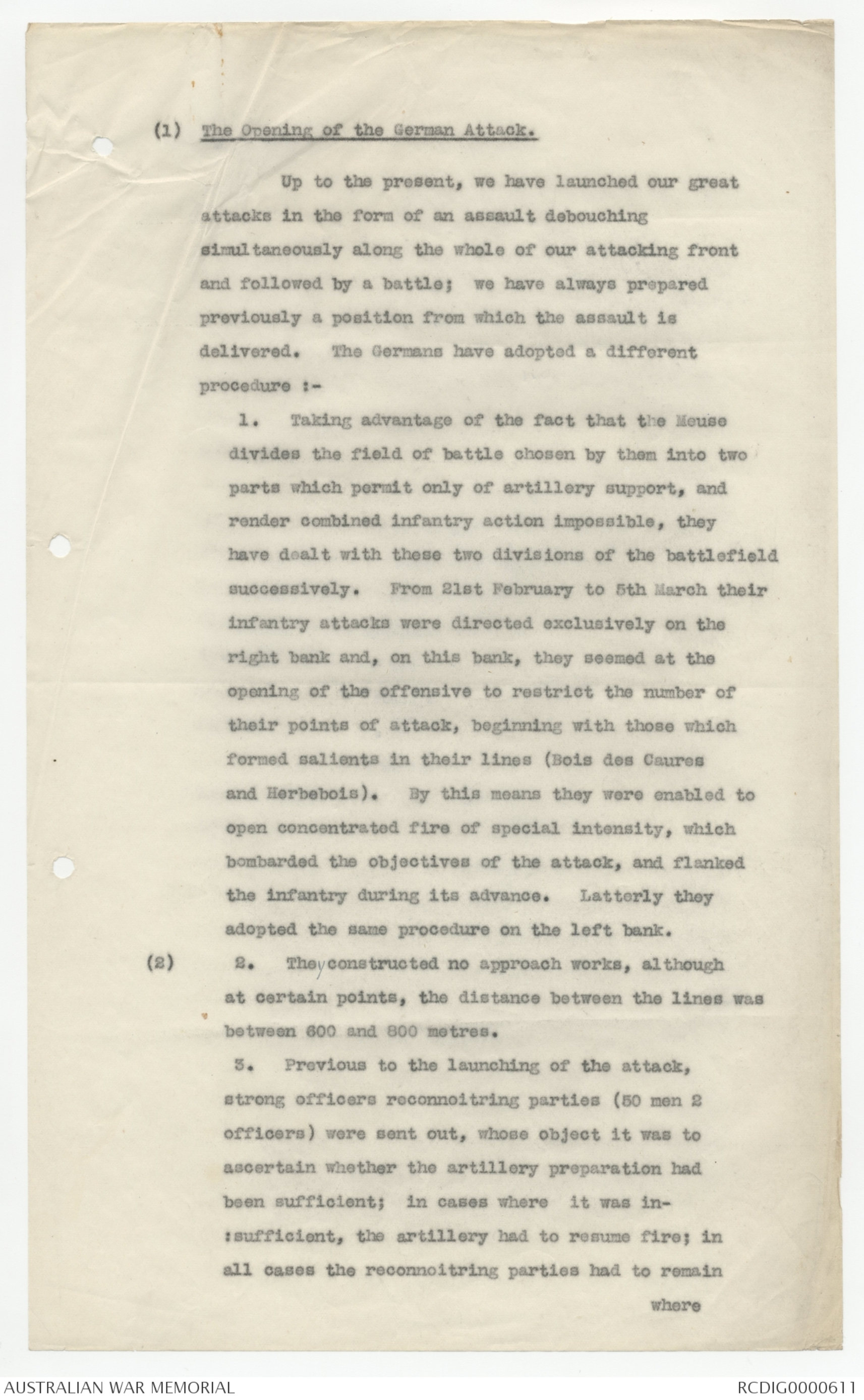
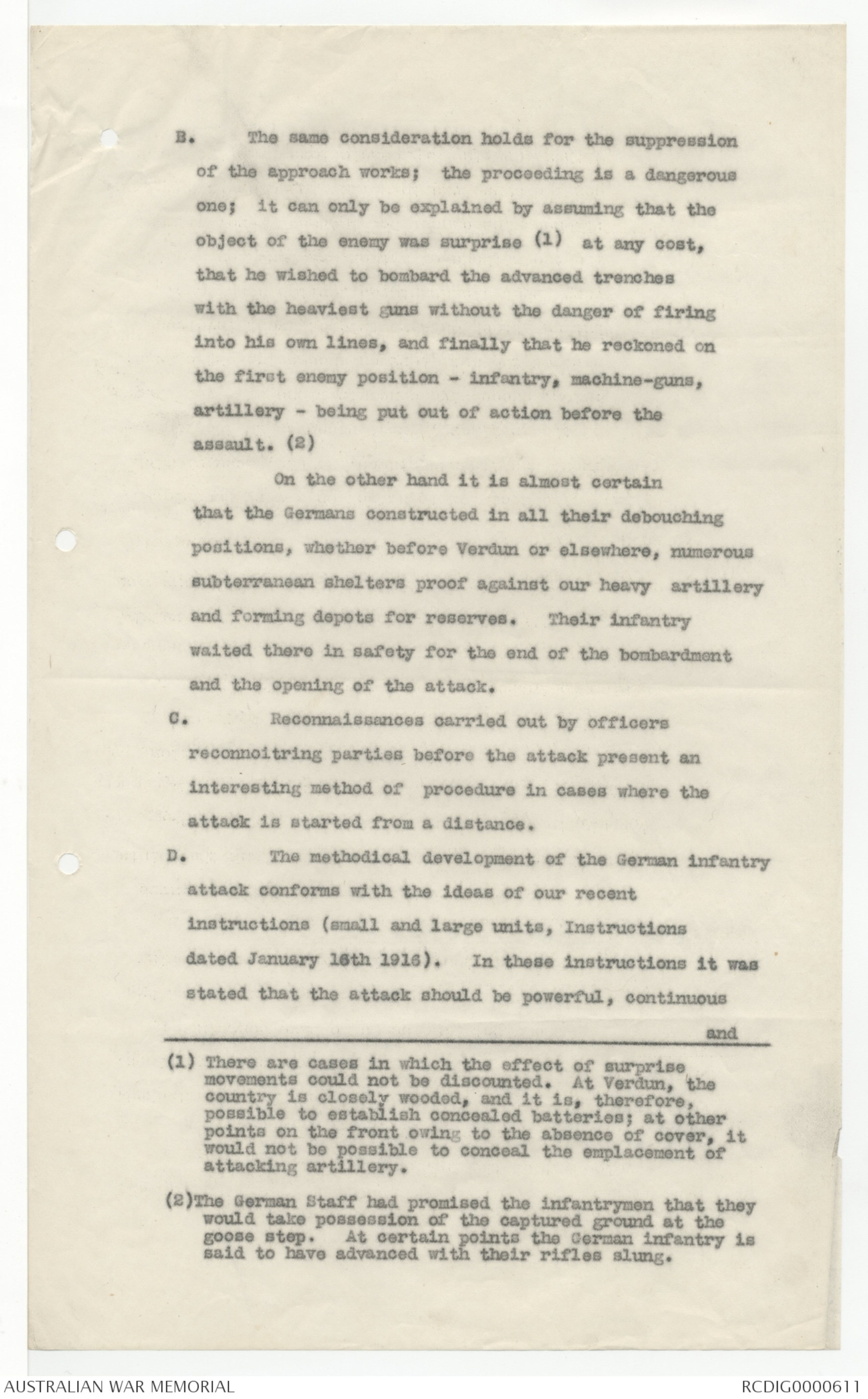
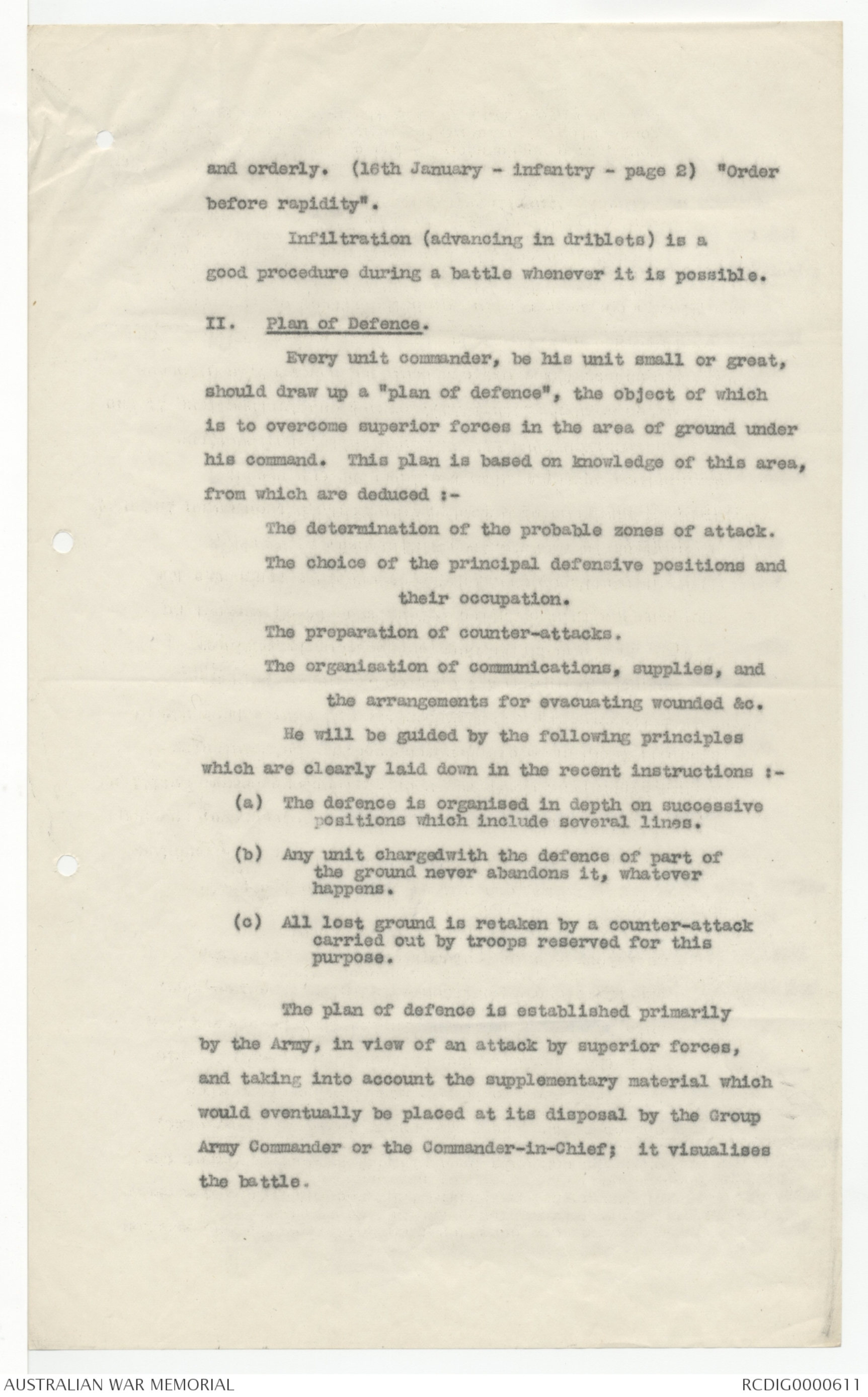
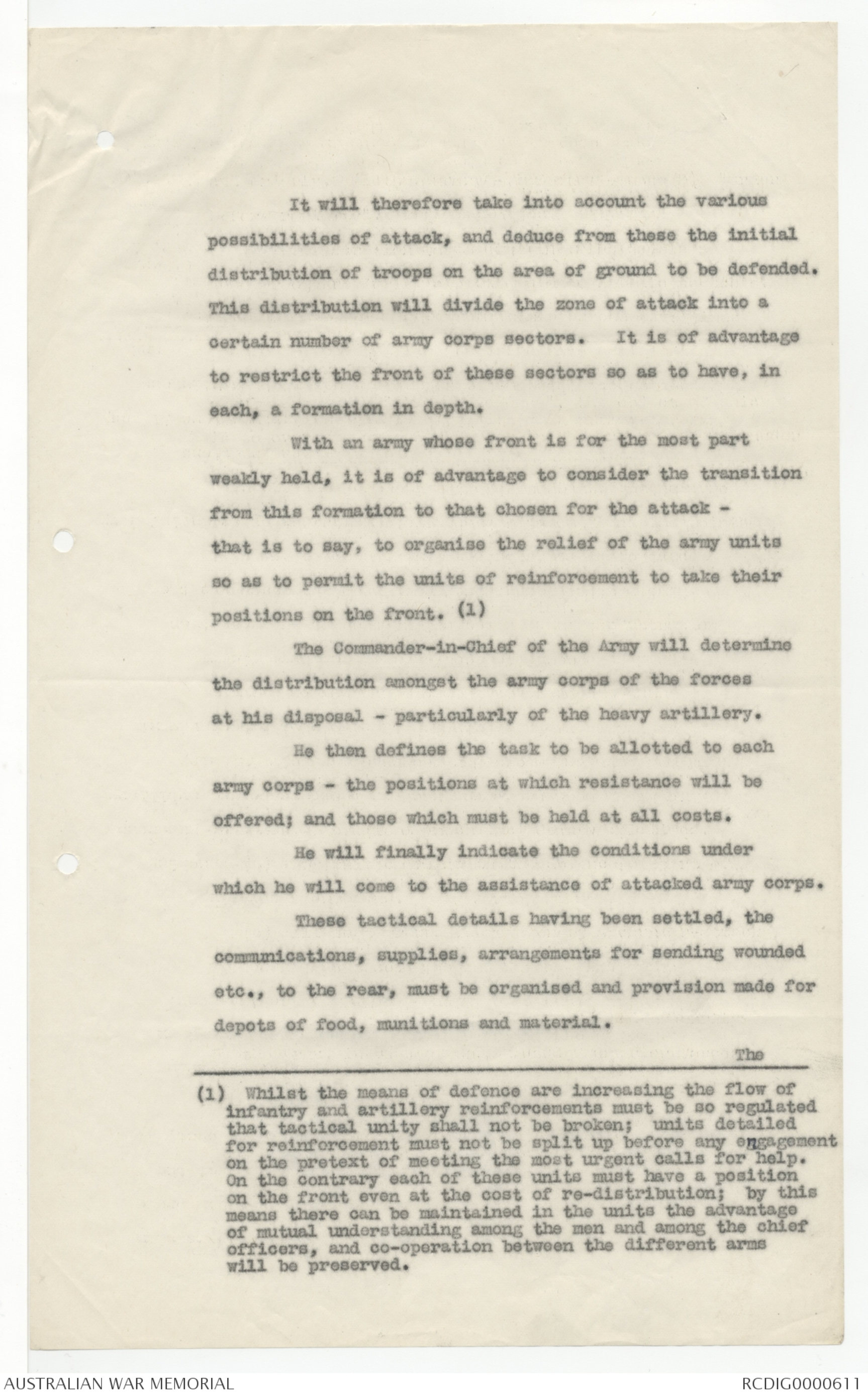
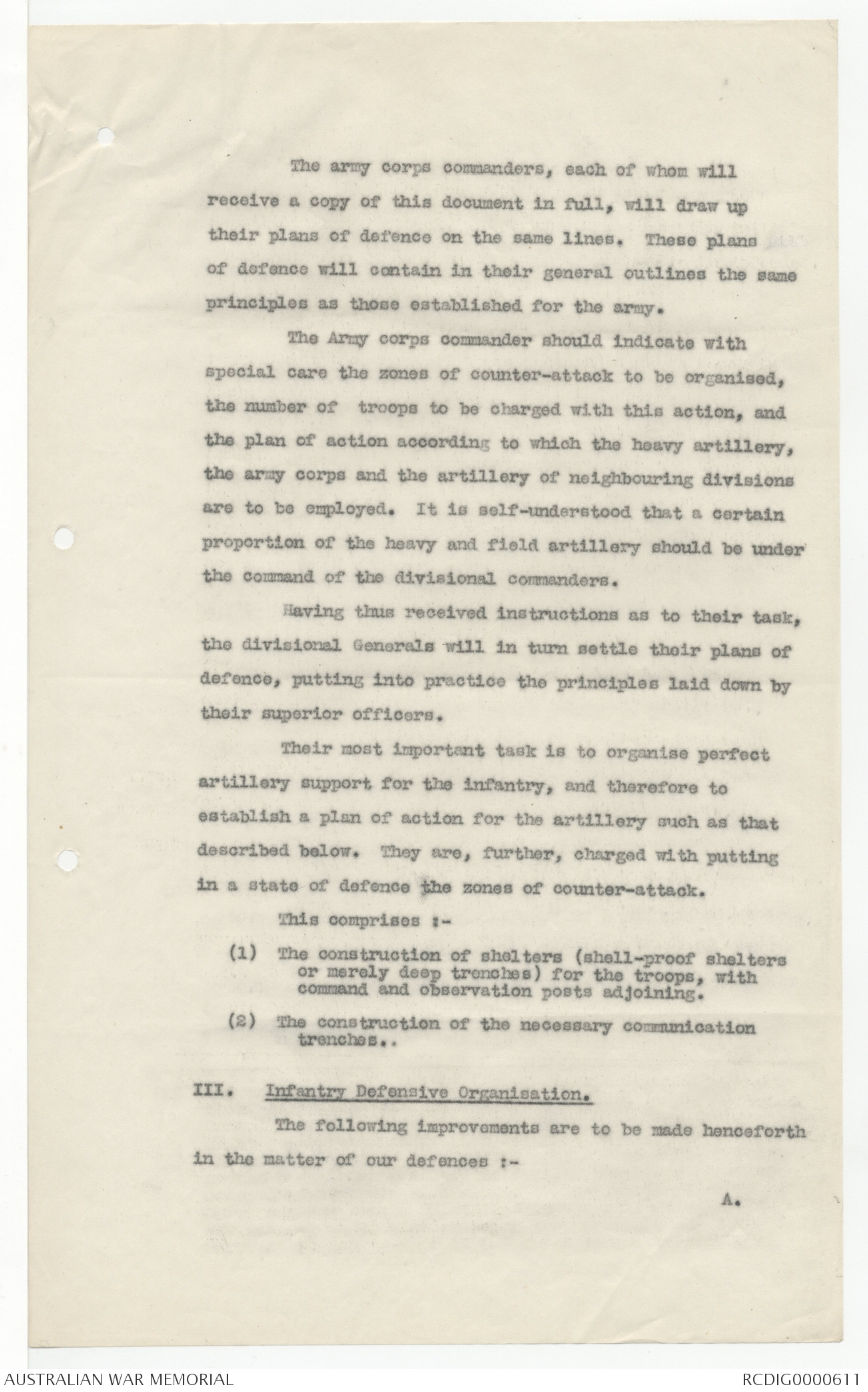
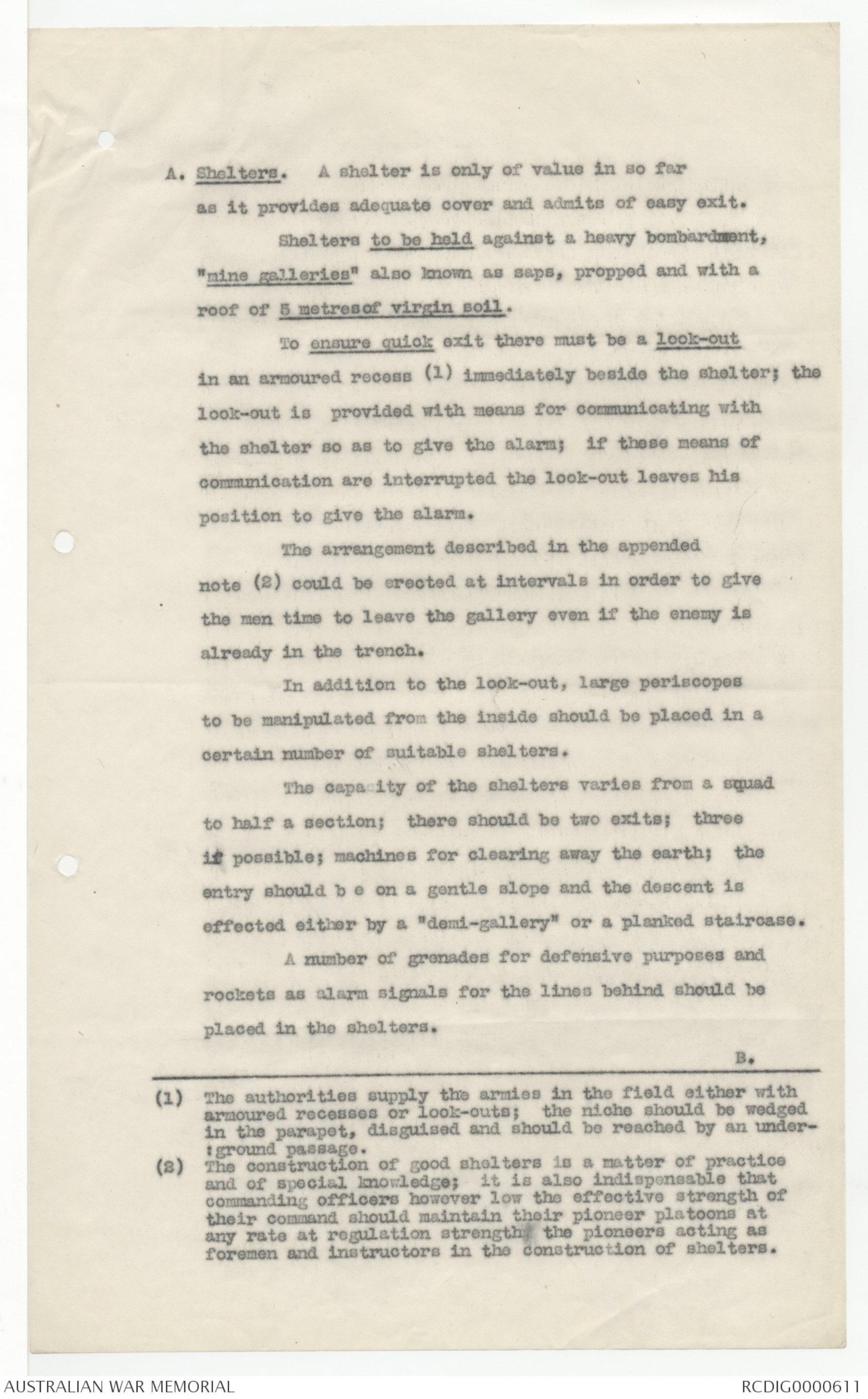
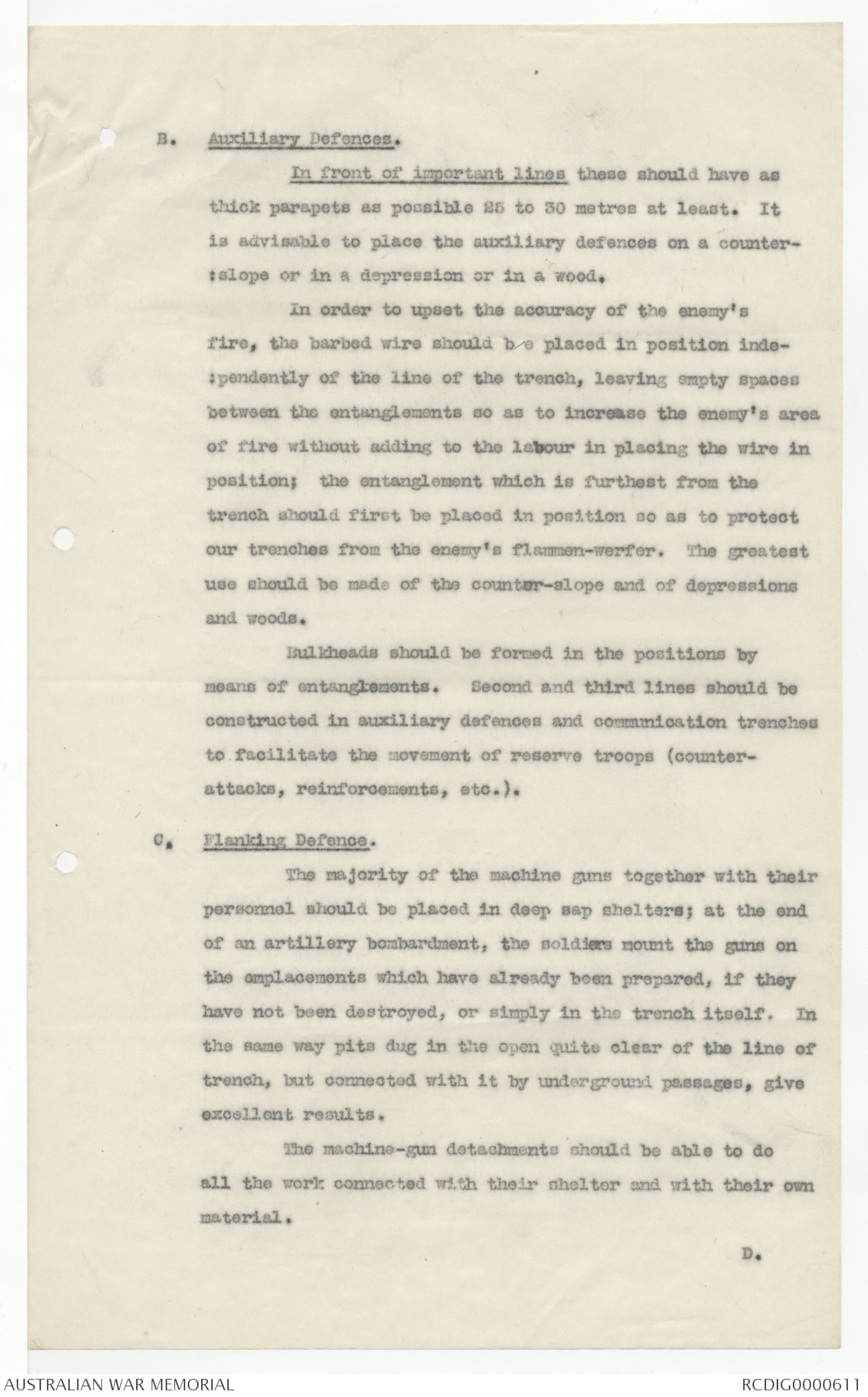
are any complaints regarding quality or price
8. He visits the latrines, washing places
and other conveniences used by the
men troops and takes action on
case of any irregularity
9. He instructs the Regtl. Orderly officers to
report to him personally on completing
their duty and furnish him with
a copy of their report within an
hour of the conclusion of their
work.
10. He will inform his successor of any
orders issued.
11. When commencing his tour of
He should commence his tour of
duty by reporting to the Field
Officer of the previous day
or he s
He should read the x report of the
Field Officer for the previous day
as soon as possible.
[*4th AUSTRALIAN OFFICE
No GC 6/6
27 MAY 1916*]
4a
40/W.O./3061.
General Headquarters
of the Eastern
Forces.
General Headquarters
5th April, 1916.
Headquarters Staff
3rd Bureau.
2.716.
MEMORANDUM relating to the Experience gained from the
Verdun Actions.
The battle in the neighbourhood of Verdun is the
first defensive action which we have had to sustain for
the last sixteen months; it furnishes a certain number
of lessons, particularly with regard to defensive warfare.
If the German onslaughts have proved the necessity
of re-organising certain details of our defensive works,
or of meeting certain methods of offensive action, they
have not given rise to incidents which invalidate the
instructions recently issued and now in force; (i) on the
contrary they have confirmed them, and have proved that
grave consequences will be involved should they be disregarded
The various lessons which should be brought to
the notice of the forces are grouped in the following five
paragraphs:-
(1)
_____________________________________________________________
(1) Instructions on offensive actions by small units.
" " " " " large "
Instructions issued on Jan. 16 relating to the purpose
and conditions of a concerted offensive action.
where they were.
4. The following methods were noticed in the
development of the infantry attack.
Relatively small forces were engaged,
though sufficient to make the point d'appui attacked.
Attacks were undertaken by successive lines.
The first line seems to have contained a
very considerable number of bombers, accompanied by
wire cutters and pioneers with small flame-throwing
apparatus.
The Germans made every effort to manoeuvre
during their initial attacks - to outflank the points
d'appui, to creep round the rear, to deploy etc.,
in other words to act with orderliness and calm.
Specially to be noted is their use of infiltration
(advancing in driblets) by which means they were
enabled to introduce themselves into all the
interstices of our defensive works.
Whilst there is good reason to make careful
note of these various methods, they do not in any way
constitute models to be imitated in every case.
A. The decision to attack on a very restricted
front has its advantages, namely, accumulation
of the artillery, great reserves in deep formation,
successive concentrations of a very large
part of the artillery on successive objectives;
but an attack on a restricted front involved
very great disadvantages for the assailant.
The two methods of attack are based on
considerations which cannot be discussed here, we must
confine ourselves to noting the enemy's procedure
without drawing any conclusions from it.
B.
(1) The Opening of the German Attack.
Up to the present, we have launched our great
attacks in the form of an assault debouching
simultaneously along the whole of our attacking front
and followed by a battle; we have always prepared
previously a position from which the assault is
delivered. The Germans have adopted a different
procedure:-
1. Taking advantage of the fact that the Meuse
divides the field of battle chosen by them into two
parts which permit only of artillery support, and
render combined infantry action impossible, they
have dealt with these two divisions of the battlefield
successively. From 21st February to 5th March their
infantry attacks were directed exclusively on the
right bank and, on this bank, they seemed at the
opening of the offensive to restrict the number of
their points of attack, beginning with those which
formed salients in their lines (Bois des Caures
and Herbebois). By this means they were enabled to
open concentrated fire of special intensity, which
bombarded the objectives of the attack, and flanked
the infantry during its advance. Latterly they
adopted the same procedure on the left bank.
(2) 2. They constructed no approach works, although
at certain points, the distance between the lines was
between 600 and 800 metres.
3. Previous to the launching of the attack,
strong officers reconnoitring parties (50 men 2
officers) were sent out, whose object it was to
ascertain whether the artillery preparation had
been sufficient; in cases where it was insufficient,
the artillery had to resume fire; in
all case the reconnoitring parties had to remain
where
B. The same consideration holds for the suppression
of the approach works; the proceeding is a dangerous
one; it can only be explained by assuming that the
object of the enemy was surprise (1) at any cost,
that he wished to bombard the advanced trenches
with the heaviest guns without the danger of firing
into his own lines, and finally that he reckoned on
the first enemy position - infantry, machine-guns,
artillery - being put out of section before the
assault. (2)
On the other hand it is almost certain
that the Germans constructed in all their debouching
positions, whether before Verdun or elsewhere, numerous
subterranean shel ters proof against our heavy artillery
and forming depots for reserves. Their infantry
waited there in safety for the end of the bombardment
and the opening of the attack.
C. Reconnaissance carried out by officers
reconnoitring parties before the attack present an
interesting method of procedure in cases where the
attack is started from a distance.
D. The methodical development of the German infantry
attack conforms with the ideas of our recent
instructions (small and large units, Instructions
dated January 16th 1916). In these instructions it was
stated that the attack should be powerful, continuous
and
__________________________________________________
(1)There are cases in which the effect of surprise
movements could not be discounted. At Verdun, the
country is closely wooded, and it is, therefore,
possible to establish concealed batteries; at other
points on the front owing to the absence of cover, it
would not be possible to conceal the emplacement of
attacking artillery.
(2) The German Staff had promised the infantrymen that they
would take possession of the captured ground at the
goose step. At certain points the German infantry is
said to have advanced with their rifles slung.
and orderly. (16th January -infantry-page 2) "Order
before rapidity".
Infiltration (advancing in driblets) is a
good procedure during a battle whenever it is possible.
11. Plan of Defence.
Every unit commander, be his unit small or great,
should draw up a "plan of defence", the object of which
is to overcome superior forces in the area of ground under
his command. This plan is based on knowledge of this area,
from which are deduced:
The determination of the probable zones of attack.
The choice of the principal defensive positions and
their occupation.
The preparation of counter-attacks.
The organisation of communications, supplies, and
the arrangements for evacuating wounded &c.
He will be guided by the following principles
which are clearly laid down in the recent instructions :-
(a) The defence is organised in depth on successive
positions which include several lines.
(b) Any unit chargedwith the defence or part of
the ground never abandons it, whatever
happens.
(c) All lost ground is retaken by a counter-attack
carried out by troops reserved for this purpose.
The plan of defence is established primarily
by the Army, in view of an attack by superior forces,
and taking into account the supplementary material which
would eventually be planned at its disposal by the Group
Army Commander or the Commander-in-Chief; it visualises
the battle.
It will therefore take into account the various
possibilities of attack, and deduce from these the initial
distribution of troops on the area of ground to be defended.
This distribution will divide the zone of attack into a
number of army corps sectors. It is of advantage
to restrict the front of these sectors so as to have, in
each, a formation in depth.
With an army whose front is for the most part
weakly held, it is of advantage to consider the transition
from this formation to that chosen for the attack -
that is to say, to organise the relief of the army units
so as to permit the units of reinforcement to take their
positions on the front. (1)
The Commander-in-Chief of the Army will determine
the distribution amongst the army corps of the forces
at his disposal - particularly of the heavy artillery.
He then defines the task to be allotted to each
army corps - the positions at which resistance will be
offered; and those which must be held at all costs.
He will finally indicate the conditions under
which he will come to the assistance of attacked army corps.
These tactical details having been setteled, the
communications, supplies, arrangements for sending wounded
etc., to the rear, must be organised and provision made for
depots of food, munitions and material.
The
________________________________________________________
(1) Whilst the means of defence are increasing the flow of
infantry and artillery reinforcements must be so regulated
that tactical unity shall not be broken; units detailed
for reinforcement must not be split before any engagement
on the pretext of meeting the most urgent calls for help.
On the contrary each of these units must have a position
on the front even at the cost of re-distribution; by this
means there can be maintained in the units the advantage
of mutual understanding among the men and among the chief
officers, and co-operation between the different arms
will be preserved.
The army commanders, each of whom will
receive a copy of this document in full, will draw up
their plans of defence on the same lines. These plans
of defence will contain in their general outlines the same
principles as those established for the army.
The Army corps commander should indicate with
special care the zones of counter-attack to be organised,
the number of troops to be charged with this action, and
the plan of action according to which the heavy artillery,
the army corps and the artillery of neighbouring divisions
are to be employed. It is self-understood that a certain
proportion of the heavy and field artillery should be under
the command of the divisional commanders.
Having thus received instructions as their task,
the divisional Generals will in turn settle their plans of
defence, putting into practice the principles laid down by
their superior officers.
The most important task is to organise perfect
artillery support for the infantry, and therefore to
establish a plan of action for the artillery such as that
described below. They are further, charged with putting
in a state of defence the zones of counter-attack.
This comprises :-
(1) The construction of shelters (shell-proof shelters
or merely deep trenches) for the troops, with
command and observation posts adjoining.
(2) The construction of the necessary communication
trenches.
III. Infantry Defensive Organisation.
The following improvements are to be made henceforth
in the matter of our defence:-
A.
A. Shelters. A shelter is only of value in so far
as it provides adequate cover and admits of easy exit.
Shelters to be held against a heavy bombardment,
"mine galleries" also known as saps, propped and with a
roof of 5 metresof virgin soil.
To ensure quick exit there must be a look-out
in an armoured recess (1) immediately beside the shelter; the
look-out is provided with means for communicating with
the shelter so as to give the alarm; if these means of
communication are interrupted the look-out leaves his
position to give the alarm.
The arrangement described in the appended
note (2) could be erected at intervals in order to give
the men time to leave the gallery if the enemy is
already in the trench.
In addition to the look-out, large periscopes
to be manipulated from the inside should be placed in a
certain number of suitable shelters.
The capacity of the shelters varies from a squad
to half a section; there should be two exits; three
if possible; machines for clearing away the earth; the
entry should b e on a gentle slope and the descent is
effected either by a "demi-gallery" or a planked staircase.
A number of grenades for defensive purposes and
rockets as alarm signals for the lines should be
placed in the shelters.
B.
_____________________________________________________
(1) The authorities supply the armies in the field either with
armoured recesses or look-outs; the niche should be wedged
in the parapet, disguised and should be reached by an under-:ground
passage.
(2) The construction of good shelters is a matter of practice
and of special knowledge; it is also indispensable that
commanding officers however low the effective strength of
their command should maintain their pioneer platoons at
any rate at regulation strength; the pioneers acting as
foremen and instructors in the construction of shelters.
B. Auxiliary Defences.
In front of important lines these should have as
thick parapets as possible 25 to 30 metres at least. It
is advisable to place the auxiliary defences on a counterslope
or in a depression or in a wood.
In order to upset the accuracy of the enemy's
fire, the barbed wire should be placed in position independently
of the lines of the trench, leaving empty spaces
between the entanglements so as to increase the enemy's area
of fire without adding to the labour in placing the wire in
position; the entanglement which is furthest from the
trench should first be placed in position so as to protect
our trenches from the enemy's flammen-werfer. The greatest
use should be made of the counter-slope and of depressions
and woods.
Bulkheads should be formed in the positions by
means of entanglements. Second and third lines should be
constructed in auxiliary defences and communication trenches
to facilitate the movement of reserve troops (counter-attacks,
reinforcements, etc.).
C. Flanking Defence.
The majority of the machine guns together with their
personnel should be placed in deep sap shelters; at the end
of an artillery bombardment, the soldiers mount the guns on
the emplacements which have already been prepared, if they
have not been destroyed, or simply in the trench itself. In
the same way pits dug in the open quite clear of the line of
trench, but connected with it by underground passage, give
excellent results.
The machine-gun detachments should be able to do
all the work connected with their shelter and with their own
material.
D.
 Transcriber 6897
Transcriber 6897This transcription item is now locked to you for editing. To release the lock either Save your changes or Cancel.
This lock will be automatically released after 60 minutes of inactivity.